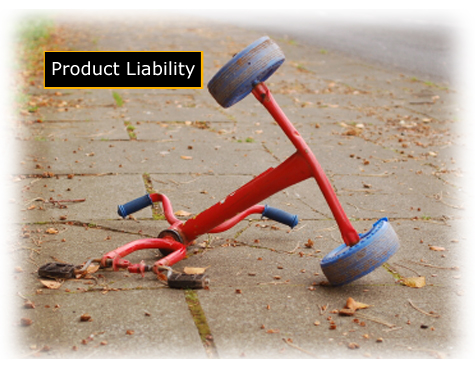|
Our homes and workplaces are full of machines, gadgets and tools that make life easier and more convenient. However, when those products are defective, they can cause serious personal injury or even death. Businesses that design, produce and sell products generally have a duty to do so in a way that does not result in harm to the buying public. Most product liability cases fall under three main categories: defective manufacturing, defective design, and the failure to provide clear and adequate warnings or instructions.
What is Product Liability?Product liability holds manufacturers or retailers responsible for any harm or injury their product may cause to consumers. A product should meet the ordinary expectations of a consumer. However, when the product fails to meet the expectations of an ordinary consumer or is thought to be dangerous, the product is said to be defective and unreasonably dangerous. Responsibility for a product liability case may lie with all the sellers in a distribution chain.
Exceptions to LiabilitySome products have benefits that outweigh the risks, and they cannot be made safer without losing usefulness. Prescription drugs and vaccines are examples. You may not have a viable case if you use a product in a way it was not intended to be used. For example, harm from using a blow dryer in the shower is not a product liability case.
Proof for Product LiabilityThe product which caused the harm must be manufactured or sold by the person you are attempting to sue. The product must have a defect and that defect must be the cause of the injuries.
Defective Manufacturing Most products we use on a daily basis are safe when used the way the manufacturer intended. There are times, however, when some products are not built correctly, have defective parts or are not properly tested before being sold to a trusting consumer. The impact of defective manufacturing can be costly. Imagine the potential tragedy from driving on tires built with bad rubber. Defective tires have resulted in numerous deaths in the US. What if you are mowing your lawn with a mower that didn’t have the necessary safety guards installed during assembly at the factory? Amputations have resulted from defective lawn mowers. What if your loved one is taking prescription medication from a batch that contains a poison that should not have been included in the ingredients? Serious injury and death have been reported from pharmaceutical manufacturing defects.
Companies facing defective manufacturing claims may not readily admit they made any mistakes. It often takes a skilled personal injury lawyer to sort through the facts, find reports from experts and even subpoena the company’s internal records or compel witness testimony. If you were injured from a defective product, tool or machine, talk to a personal injury attorney today to see if you can recover for your losses.
Defective DesignAnother form of product liability that often leads to personal injury or death is known as defective design. Unlike defective manufacturing, where an otherwise good product is sold containing bad materials or bad parts, products with a defective design are inherently dangerous. For example, plaintiffs have alleged that a well-known car company created an inherently dangerous situation with the design and placement of its gas tank that would explode in rear-end collisions. The gas tank was built and installed according to specifications, but the design itself created risk. To make matters worse, plaintiffs alleged that the car company knew of the danger and did nothing to correct it.
Defective design cases usually cause injury to more than one person since the defective design affects the entire inventory of products. While the product might seem safe to most users (for example, driving a car and not being rear-ended), the danger becomes known when a combination of events happen at the same time. As another example, consider a coffee maker that can cause electrocution when it overflows. Most people don’t experience an overflowing coffee maker, but when it happens to the wrong person at the wrong time, the result can be traumatic.
Too many people are injured every year from products that are inherently unsafe. From sunglasses that cause permanent eye injuries by not offering UV protection as promised to vaccines that allegedly cause autism in children, consumers should not be left suffering from these avoidable results. Whether it’s medical bills, ongoing therapy, lost wages, destroyed relationships or emotional trauma, if you have been injured by a defective or poorly designed product, tool or device, an experienced personal injury attorney can help you determine if you have a product liability claim.
Failure to Warn or InstructMany product liability cases involve pharmaceuticals and poor labeling (although industrial machines and even household goods with inadequate or missing warnings can also fall into this category). A toxic ingredient accidentally added to a medication might be considered a manufacturing defect. Injuries resulting from a lack of important warnings or proper instruction, on the other hand, are referred to as failure to warn cases.
For example, you may have been taking your medication after thoroughly reading the information provided on the bottle. You also take a common over-the-counter painkiller for a headache, and all of a sudden you’re in the hospital because the combination of drugs caused a dangerous adverse reaction. If your medication failed to warn against taking aspirin with it, then the manufacturer (or even the pharmacy or your physician) may be at fault for failing to warn you of the potential danger.
Lawyers Are IndispensableIt might go without saying, but suing a large corporation is not something you should try and figure out on your own. Having an experienced lawyer on your side is necessary to navigate the complicate lawsuit process. Even negotiating with companies or lawyers before filing a lawsuit is a difficult and complex process. Contact an attorney to discuss your options. Lawyers often offer free consultations for these types of cases.
|